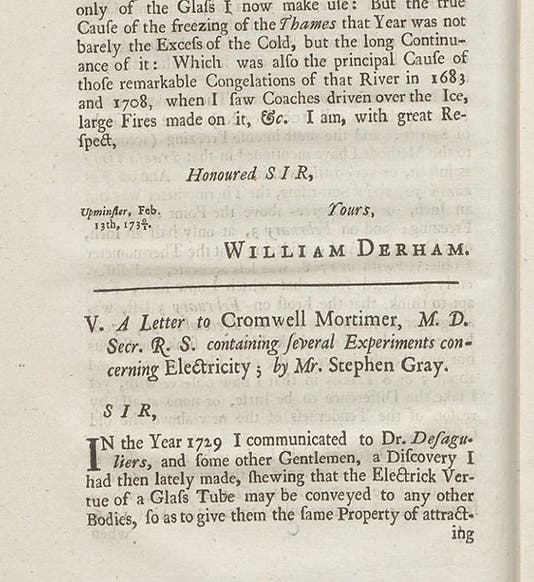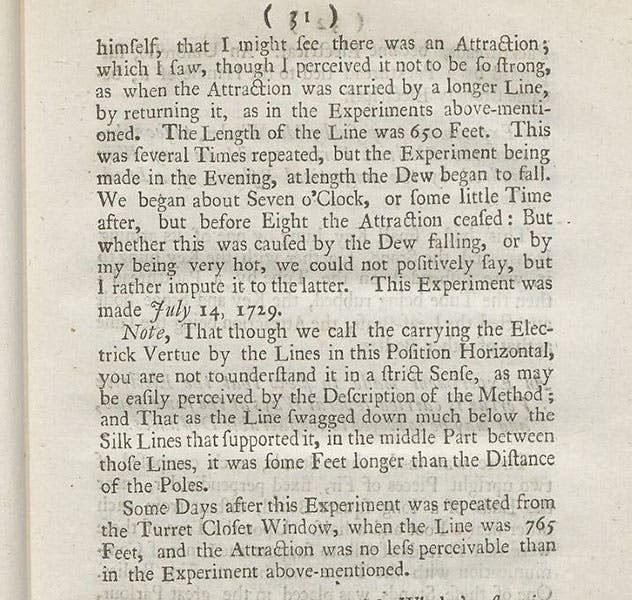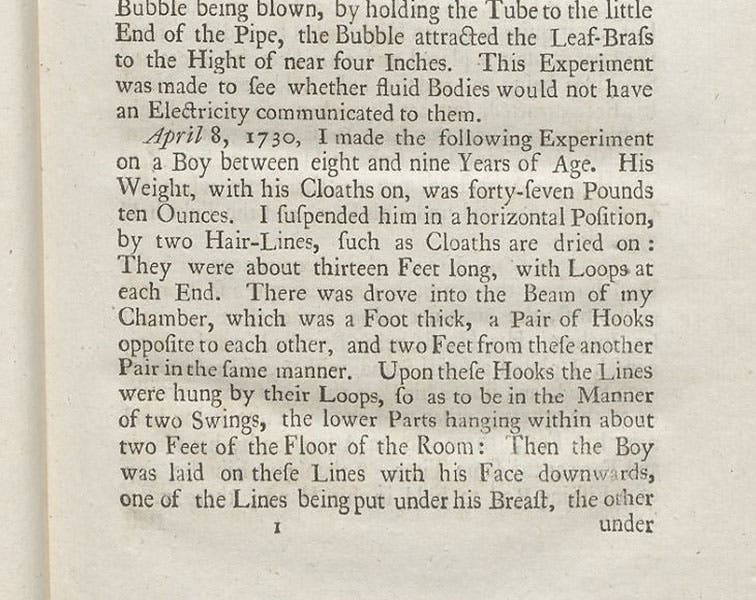Scientist of the Day - Stephen Gray
Stephen Gray, an English astronomer and experimental physicist, died Feb. 7, 1736, at age 70. There were two English experimenters investigating electricity in the years around 1708: Stephen Gray and Francis Hauksbee. Hauksbee was a protégé of Isaac Newton, who was President of the Royal Society; Gray was good friends with John Flamsteed, a bitter enemy of Newton. Gray seems to have made some discoveries that turned up in papers published by Hauksbee. Gray had only one paper that appeared in the Philosophical Transactions while Newton was president of the Royal Society; Hauksbee had many. It has been argued that Gray was suppressed by the Newtonian cabal. Others are not so sure that Gray had that much to say while Newton was alive.
Whatever was the case, Gray outlived Newton, who died in 1727; in 1729, Gray made his greatest discovery of all: electrical conduction. Until 1729, electrical investigation consisted of rubbing glass tubes with cloth and attracting – or repelling – small bits of chaff. Hauksbee had invented an electrostatic generator, a rotating glass globe that could accumulate a great deal of charge, but it was used pretty much the way glass tubes were used. At the time, the word "electric" was used for something that could accumulate charge, like glass, while “non-electrics” were those kinds of materials that would not hold a charge, like nearly all metals. This can be confusing to the modern reader, so just remember that what we call a good conductor, like copper, was a non-electric to Hauksbee and Gray.
In his experiments of 1729, Gray first discovered that if you put a cork in the end of a rubbed glass tube, the cork would attract chaff, even though it had not been rubbed. Electricity was somehow being conducted to the cork. He put a stick in the end of the cork, and found that it too was attractive. Then he hung a packthread from the end of the stick, tied an ivory ball to the end of the cord, and found that the ball would attract chaff when the glass tube was rubbed. He found that this would work up to a distance of 60 feet, which was as high as he could take his electrical fishing pole. Gray then tried stringing the cord horizontally, hanging it from beams with wire, but nothing happened. When he substituted silk cords for the metal wire, the thread conducted. Eventually, working at a friend’s estate in the country, he was able to conduct electricity on his packthread to a distance of over 750 feet. The discovery of conduction opened up a brand new avenue to electrical investigators. Eventually, after Gray's time, it would be discovered that metals are a much better conductor than packthread, but metal wires have to be insulated from ground or the charges disappear.
Gray published his results in the Philosophical Transactions in the volume for 1731-32, with the unpretentious title, "A Letter ... containing several Experiments concerning Electricity." The paper is not illustrated, so we show you several pages of text – the first page, and the page where he described his successful conduction to 765 feet (second image). He also described, in this paper, an ingenious demonstration experiment. He suspended a schoolboy from the ceiling by several silk cords and discovered that the boy could be electrified and would attract or repel all manner of small objects. This experiment would be often repeated in the 1740s and 1750s, using electrostatic generators instead of glass tubes, so that a dramatic discharge could be coaxed from the poor lad’s fingers. We showed such a demonstration in our post on Jean-Antoine Nollet, where it is the third image.
For his discovery of electrical conduction, Gray was awarded the first Copley Medal ever bestowed by the Society, in 1731, and he won the second one as well. His work was a great influence on Charles du Fay, who would discover in the 1730s that there are two kinds of electrical charge, later called positive and negative by Benjamin Franklin. But after his death in 1736, Gray faded from view, and except for his prominent mention by du Fay, Gray disappeared from the history of electrical science for a long period. Fortunately, he now gets his due.
Gray lived a very ordinary life outside the laboratory. There is no known portrait. He had almost no money, and around 1720, he managed, with the help of the Secretary of the Royal Society, to be appointed a "pensioneer" of the Charterhouse in London, a charitable institution that included a school for boys, a hospital, and residential arrangements for older men who had served society well and had no means of support. Since we do not have any other images to adorn this post, we include an engraving of the Charterhouse from 1739 (fourth image). Thomas Burnet, who wrote the first "Theory of the Earth," was Master of Charterhouse for thirty years, but he died in 1715, before Gray came on board. Gray lived there until his death and is buried somewhere on the grounds, although the actual location of his grave is unknown.
Dr. William B. Ashworth, Jr., Consultant for the History of Science, Linda Hall Library and Associate Professor emeritus, Department of History, University of Missouri-Kansas City. Comments or corrections are welcome; please direct to ashworthw@umkc.edu.








![Columbine, hand-colored woodcut, [Gart der Gesundheit], printed by Peter Schoeffer, Mainz, chap. 162, 1485 (Linda Hall Library)](https://assets-us-01.kc-usercontent.com:443/9dd25524-761a-000d-d79f-86a5086d4774/3829b99e-a030-4a36-8bdd-27295454c30c/gart1.jpg?w=210&h=210&auto=format&fit=crop)
